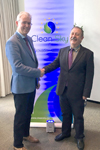
April 20th, 2017
For the second newsletter of 2017, the EASN Association is pleased to host an interview between Mr. Christophe Hermans and Prof. Spiros Pantelakis about the established Cooperation Agreement between CEAS and EASN.
Q1: What are you expecting from this cooperation?
Mr. Christophe Hermans (CH): For those who are not familiar with CEAS, it is good to know that CEAS is a not-for-profit umbrella organization of 13 national aerospace societies in Europe. CEAS was established 25 years ago and currently represents more than 34.000 professionals in the field. According to CEAS statutes, its mission is to develop a framework for encouraging cooperation in Europe, stimulating aerospace R&D and provide a platform for dissemination of its results also for our cooperate members ESA, EUROAVIA, VKI, LAETA, EASA and Eurocontrol. To create an even wider international community, CEAS has established links to the European research establishments (EREA), the aeronautical industry (ASD), the European Defense Agency (EDA) and the joint technology initiative CleanSky. Both EASN and CEAS aims are the advancement of the aeronautics sciences and technology in Europe. For achieving this we both provide services and conduct activities some of which are quite similar, others are rather complementary. By joining forces in certain areas I'm convinced we both can reach out to more professions, increase our impact and be more efficient in organizing events. Were traditionally EASN has strong links with universities and thus scientists and CEAS with industry, applied research and thus engineers, shows already that we can reinforce each other.
Prof. Spiros Pantelakis (SP): With CEAS being a not-for-profit umbrella organization of 13 national aerospace societies in Europe and EASN being a not-for-profit Association of the European Academia involving presently more than 350 members this Cooperation Agreement is a natural linking of two complementary entities. Together we are both stronger and can better serve our common aims which are the advancement of the aeronautics science, the support of education and research and the development of technology in Europe.
Q2: What could be, in your view, its practical implementation?
CH: We both have successfully organized thematic events and aerospace conferences in the past years, covering a comprehensive range of relevant subjects to promote knowledge dissemination. This is why we have agreed from 2019 onwards to jointly organize the European aerospace conferences with a joined technical committee. This will of course be beneficial for both of our organizations, i.e. our members, but especially for the total European aerospace community. Jointly we can offer a broader technical conference program and better networking opportunities.
We also have started talks about a collaboration scheme on publishing the outcome of research activities in the Aeronautical and Space journals currently published by CEAS in collaboration with DLR, ESA and Springer.
SP: As a first implementation step of this Cooperation Agreement I am happy to announce that from the year 2018 onwards the Conferences of EASN and CEAS will be joined to one European Aviation Conference. I want to take the chance of this answer to invite also other Conferences to join as it is my strong belief that we don't need many fragmented Conferences every year in Europe. Furthermore we are discussing with CEAS on how the Journals of CEAS can be exploited also by the EASN Association and I am quite confident that we will find a proper way. I feel the above are not small implementation steps for a Cooperation Agreement which is just one month old.
Q3: What would be its long term perspectives?
CH: In the long run I would like to see a further harmonization and increased collaboration to have an even larger impact. I think we can create a wider European community, reaching out to all regions in Europe with strong aeronautical roots and activities, without losing our identity.
SP: I consider this Cooperation Agreement as a first but essential step to respond to the strategic need of facing fragmentation of the European Aeronautical Community. I feel the demanding goals of the European Aeronautical Community which include to retain global leadership of Europe, to realize the Flight Path 2050 for Aeronautics, to offer excellent education in aeronautics, to keep producing a vast amount of scientific knowledge and breakthrough technologies, cannot be achieved if the stakeholders remain fragmented. EASN, being the Association of Academia, is taking initiatives and is also ready to support all actions which contribute to strengthen Europe through joining forces.